A Complete Guide to Home Light Bulb Selection: From Specifications to Types
Choosing a light bulb may seem simple, but it's actually quite complex. Light bulbs for various lighting fixtures, such as chandeliers and pendants, vary in basic structure, voltage, and wattage. Choosing efficient bulbs that provide high-quality illumination is crucial if you want to create a specific atmosphere in your living or workspace.
Lighting specifications are complex, and technical terms like illuminance, color temperature, and color rendering index may seem unfamiliar to non-lighting experts, but they are essential criteria when selecting a light bulb. With so many different bulbs available and their complex technical details, choosing the right one for your fixture can be a real challenge. We've compiled this comprehensive guide to help you make the right choice.
Key Light Bulb Characteristics
Before heading to the hardware store or home improvement store to buy a light bulb, you must determine several basic factors to ensure you're getting the best possible size, functionality, and energy efficiency. Cap or Base Type
A light bulb's cap or base is the metal part that connects the bulb to the socket in a lighting fixture. It not only provides electrical contact but also secures the bulb in the fixture. Common bases for home lighting fixtures are screw-type and latch-type or hook-type.
Screw-type lampholders, also known as Edison sockets (named after the inventor Thomas Edison), are made of threaded metal and securely hold the bulb in the threaded socket. Screw-type bulbs are very common in homes, often used in decorative lighting such as chandeliers and table lamps.
Lock-type or hook-type lampholders: These lampholders have two metal rods or posts extending from the bottom of the bulb. These lampholders simply push or click into place, without twisting. They are suitable for many small incandescent bulbs and some fluorescent lamps.
When purchasing a light bulb for a fixture, it is crucial to determine the correct cap or base type. If the bulb is already installed in the fixture, remove it to check its size and base type. When purchasing a new bulb, take the old bulb with you to a hardware store or home improvement store for reference. If the lamp is new and doesn't have a bulb, note the accessory reference number so you can find a bulb that matches its specifications.
A bulb's base type or connector is identified by a code: a letter represents the base name, and a number represents the diameter (in millimeters). For example, an E27 bulb has an Edison screw base and a diameter of 27 mm; an E14 bulb has the same base but fits a smaller socket.
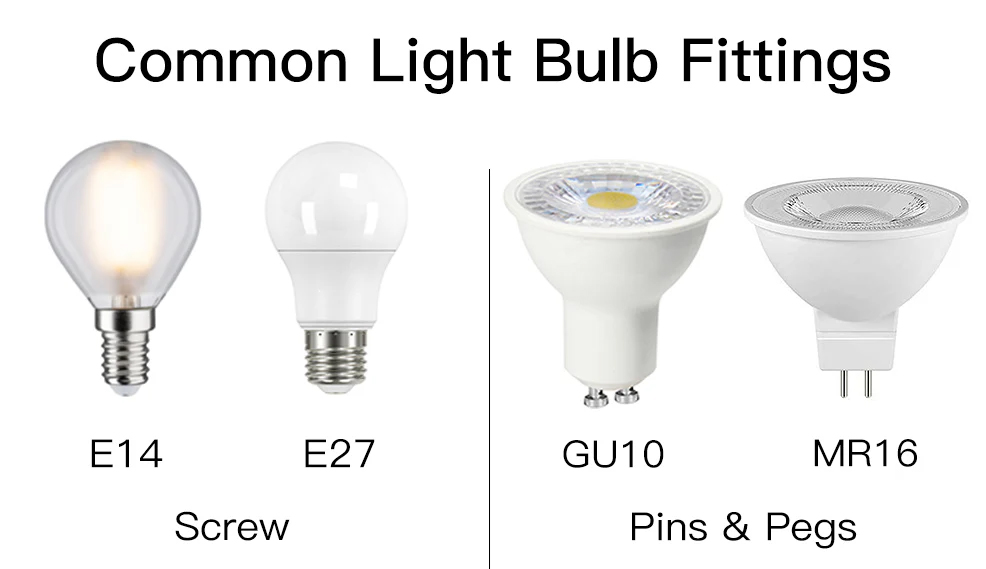
Voltage
Voltage refers to the pressure of the electrical current flowing into an electrical device, measured in volts. The standard electrical voltage in US homes is 120 volts, so most indoor lighting requires 110-120 volt bulbs. Outdoor lighting, on the other hand, typically uses low-voltage lighting, requiring 12-volt or 24-volt bulbs. Low-voltage lighting is recommended for outdoor lighting, primarily for safety reasons, as outdoor lighting is more exposed to the elements, and low voltage significantly reduces the risk of electric shock.
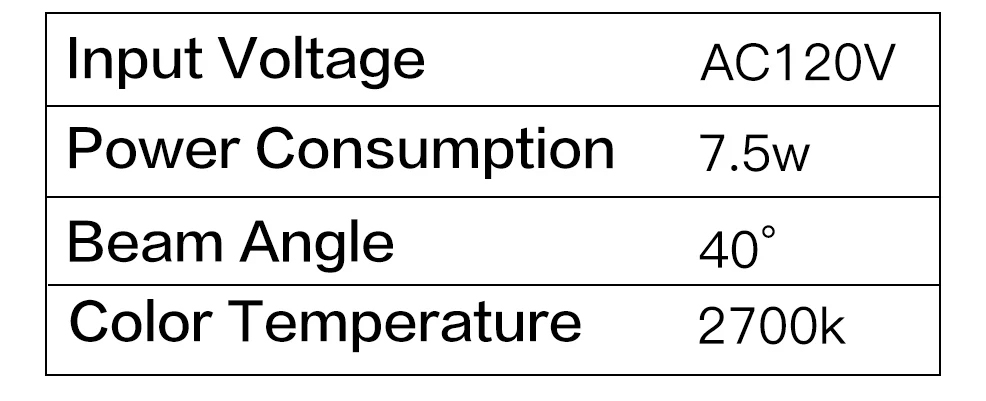
The voltage of a bulb can be found on the bulb itself or on its packaging. For optimal lighting efficiency, be sure to purchase a bulb that matches the voltage of the fixture. Using a bulb with an incompatible voltage can cause the light to not work at best, or even damage the bulb and fixture.
Wattage
Wattage is the unit of energy consumed by a bulb, measured in watts. In the past, when bulb options were limited to incandescent and halogen bulbs, wattage was used to determine brightness. However, with the advent of energy-saving bulbs, wattage is no longer a criterion for brightness. For example, LED bulbs have lower wattage but are significantly brighter.
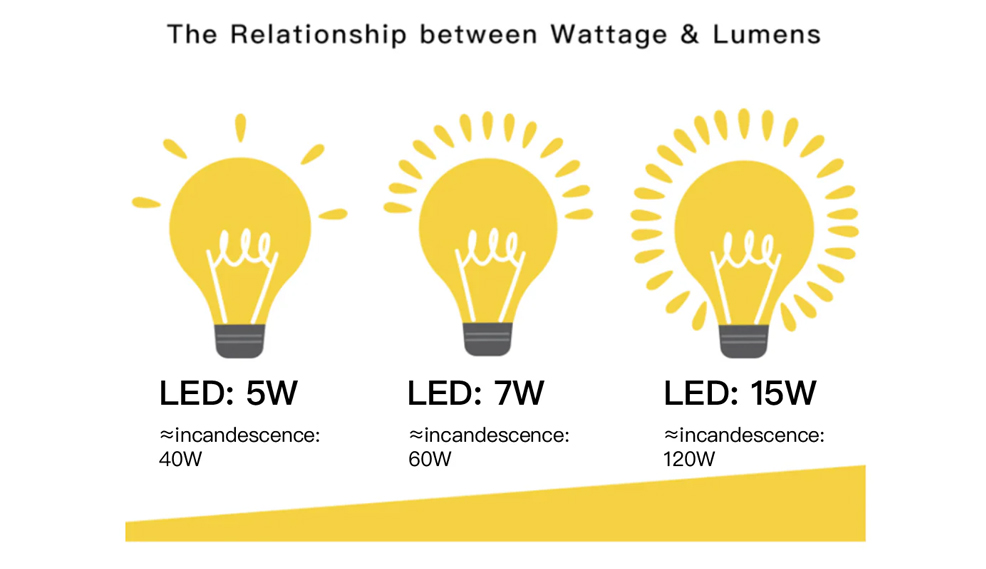
Today, brightness is measured in luminous flux (lumens, lms). Lumens indicate the amount of light a bulb emits, regardless of wattage; higher lumens indicate more light. Lumens are a more accurate indicator of brightness, and it's possible to find bulbs with lower wattage but higher lumens, which means better lighting at lower energy costs.
We recommend LED bulbs, which offer the highest light output, or lumens per watt. LED bulbs have 70-90 lumens per watt, compared to just 10 for incandescent bulbs. For example, a 5-watt LED bulb is equivalent in brightness to a 35-45-watt incandescent bulb.
However, wattage is still an important factor in determining power consumption. Higher-wattage bulbs result in higher electricity bills. Furthermore, lighting fixtures have maximum wattage ratings, which limit the wattage of bulbs that can be used in different fixtures.
When purchasing a light bulb, be sure to check the maximum wattage rating of the fixture or refer to the wattage of older bulbs. For safety reasons, choose lower-wattage bulbs with higher lumens. Avoid using bulbs that are too high, as this can damage the fixture and even create a fire hazard.
Other Parameters to Consider When Choosing a Light Bulb
Beyond considering the type of base, voltage, and wattage, other factors can significantly impact the functionality and aesthetics of your living space. Especially when creating a specific atmosphere, the following three lighting parameters can enhance comfort and convenience.
Illuminance
Illuminance is a measure of the amount of light radiated from a light source and diffused onto a given surface area. It helps determine the required brightness level for different areas of your home.
The unit of illumination is lux (lx), not to be confused with lumen (lm). Lux measures the total luminous flux (illuminance) striking a specific surface, while lumens measure the total luminous flux (luminous flux) emitted by a bulb in all directions.
Choosing a bulb that meets your desired illumination level is actually quite simple. 1 lux equals 1 lumen per square meter of space, so once you know the area you want to illuminate, you can determine the required brightness.
For example, lighting experts recommend 300-400 lumens per square meter for an office or study. A home office measuring 10 square meters would require approximately 3,000-4,000 lumens for optimal illumination.
Color Temperature
Color temperature refers to the degree of warmth or coolness of the light emitted by a light source and is measured in Kelvin (K). Higher Kelvin values indicate whiter or cooler light. In a home environment, people generally prefer warmer light sources with lower Kelvin values in low-light spaces such as bedrooms, dining rooms, and living rooms. Cooler light sources with higher Kelvin values are generally recommended for areas requiring high light levels, such as kitchens, bathrooms, and studies.
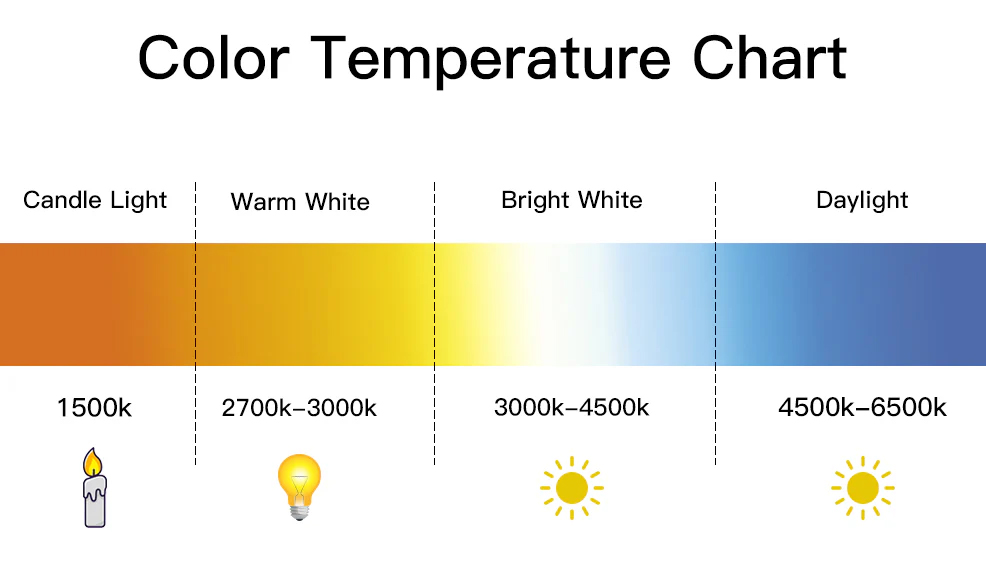
Color temperatures for residential applications are categorized as follows:
Soft white or candlelight (1500 to 2700 Kelvin): Mimics the typically yellowish tint of incandescent light, creating a warm and cozy atmosphere.
Warm white (2700 to 3000 Kelvin): A yellowish-white hue creates a brighter and more comfortable atmosphere.
Bright white (3000 to 4500 Kelvin): A blend of white and blue creates a lively and energetic feel.
Daylight (4500 to 6500 Kelvin): A bluish hue provides maximum color contrast.
While the specific choice of color temperature ultimately comes down to personal preference, lighting industry experts offer some general recommendations: Low color temperatures create warmer colors that easily create a relaxing and calming atmosphere; high color temperatures create brighter, whiter tones, ideal for enhancing efficiency and performance in work environments.
Color Rendering Index (CRI)
The color rendering index measures how well an artificial light source renders an object's true color. Midday sun is often used as a reference point, with a color rendering index of 100. A higher CRI indicates a closer representation of an object's true color.
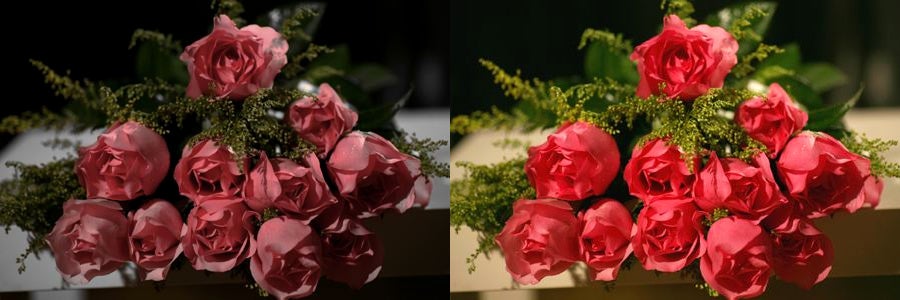
Artificial light sources with a low CRI can cause color casts and distortion, which can cause visual fatigue. For best results, choose bulbs with a high CRI. A CRI of 80 or higher is recommended for indoor lighting, and at least 65 for outdoor lighting.
Different Types of Light Bulbs
There are four main types of light bulbs commonly found on the market: incandescent, halogen, CFL, and LED. Below is an overview of the characteristics of each.
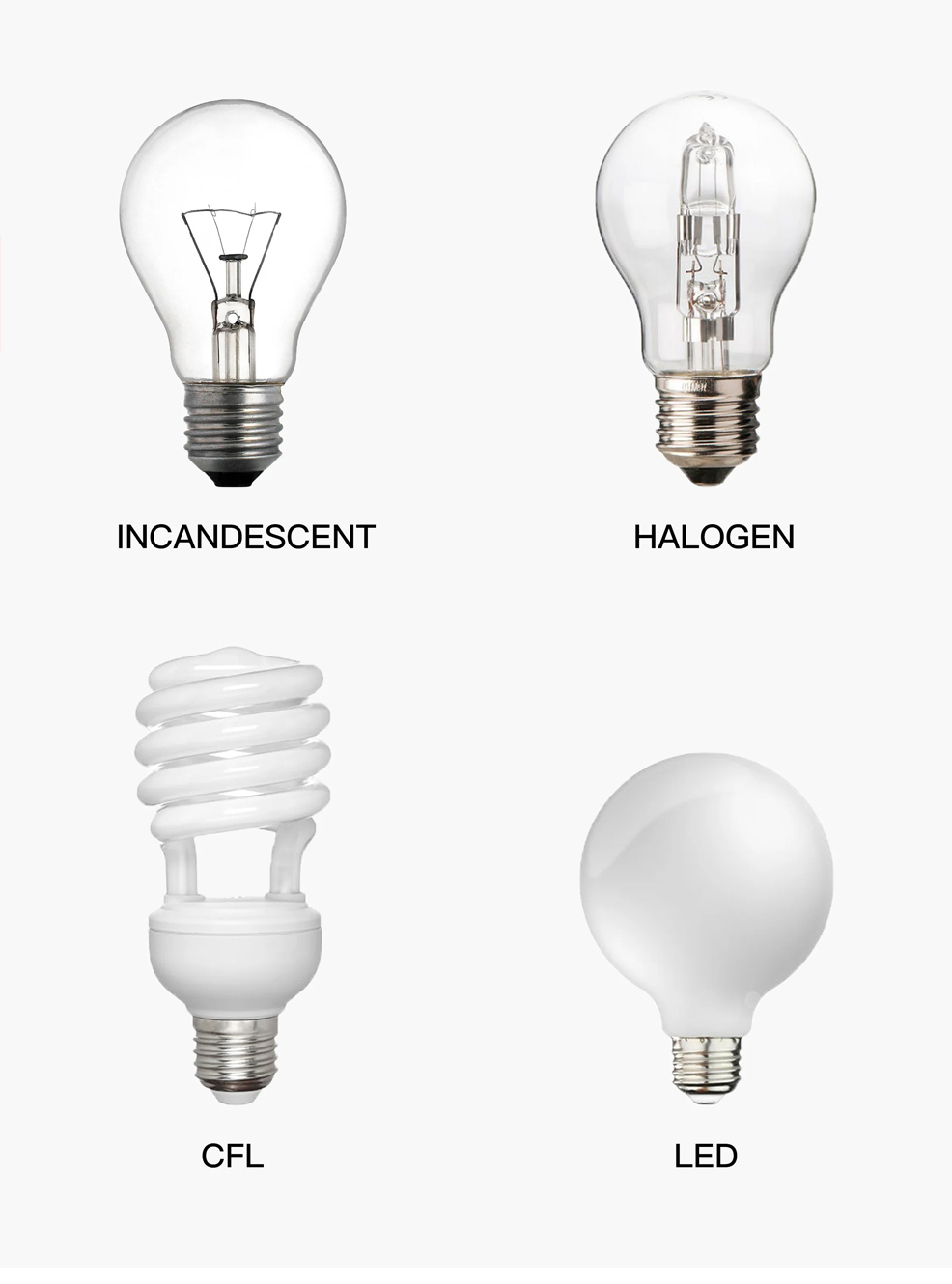
1. Incandescent Lamp
The incandescent lamp, a classic light bulb that has been around since the 19th century, produces light and heat by heating a filament to a specific temperature. Incandescent lamps are inefficient, with 90% of the energy used to heat the filament and only 10% converted into visible light. While incandescent lamps are cheaper, they also come with higher electricity bills and a shorter lifespan of approximately 1,000 hours.
2. Halogen Lamp
Halogen bulbs are essentially an improved version of incandescent bulbs. They release more heat and convert more energy into light, resulting in improved efficiency. They also have a longer lifespan of up to 2,500 hours. Halogen bulbs are made of heat-resistant quartz glass, which resists breaking due to high temperatures. Halogen gas is added to prevent the dark spots that occur in incandescent lamps due to high temperatures.
3. Compact Fluorescent Lamp (CFL)
Compact fluorescent lamps (CFLs) operate on the same principle as fluorescent lamps, but in a similar form factor. These energy-saving lamps offer advantages such as greater compactness, high efficiency, high lumen maintenance, and reduced heat dissipation. CFLs are available in a variety of shapes and sizes and have a long lifespan of over 6,000 hours. For the same amount of visible light radiation, CFLs consume only one-third to one-fifth the energy of incandescent bulbs.
4. LED Lights
LED stands for light-emitting diode, and LED bulbs use this technology to generate light. While traditional lighting sources convert electrical energy into heat before emitting light, LED bulbs convert electricity directly into light. This not only results in efficient light production, minimizing power waste, but also eliminates warm-up delays. LED bulbs offer low energy consumption, high brightness, and the longest lifespan of all bulb types, exceeding 50,000 hours. While slightly more expensive, they have become a mainstream light source due to their superior value for money.

